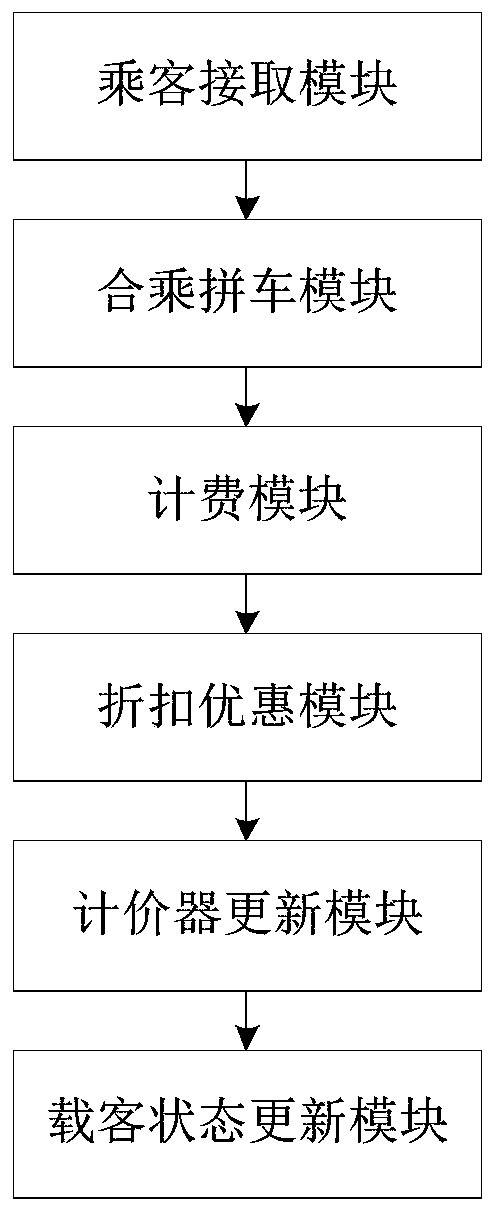Online and offline combined riding system and method for taxi
An online and offline, taxi technology, applied in the direction of fare metering, data processing applications, buying and selling/leasing transactions, etc., can solve the problem that taxis cannot realize combined rides, etc., to avoid skyrocketing prices and improve economic benefits.
- Summary
- Abstract
- Description
- Claims
- Application Information
AI Technical Summary
Problems solved by technology
Method used
Image
Examples
Embodiment
[0041] An online and offline combination ride system for taxis, comprising a taxi terminal, the taxi terminal includes a meter, and the taxi terminal is connected to the meter by communication, such as figure 1 As shown, the taxi terminal includes the following modules:
[0042] Passenger receiving module: used to obtain the passenger status of the taxi, and receive online orders or offline passengers when the taxi is empty.
[0043] Carpooling module: used to pick up offline passengers for carpooling when the first passenger needs to carpool with other passengers.
[0044] Billing module: It is used to bill according to the order in which passengers get on the bus, and displays the cost of each passenger on the meter. The meter supports up to four passengers to bill at the same time.
[0045] Discount discount module: used to obtain the preferential policies of the pricing department and provide discounts for the shared ride amount.
[0046] Meter update module: used to end...
Embodiment 2
[0062] The difference between embodiment two and embodiment one is that the online and offline combined ride system for taxis also includes the following modules:
[0063] Reminder module: used to give voice prompts to passengers when they get off the bus, prompting passengers to check their carry-on items and items stored in the trunk of the taxi.
[0064] The online and offline combined ride method for taxis includes the following steps:
[0065] S61: When a passenger gets off the bus, give a voice prompt to the passenger, reminding the passenger to check the items they carry and the items stored in the trunk of the taxi.
[0066] The specific implementation process is as follows:
[0067] When the passengers get off the bus, remind the passengers to get off and take their luggage with them, so as to prevent the passengers from leaving their luggage in the taxi and causing unnecessary trouble to the driver or passengers.
Embodiment 3
[0069] The difference between the third embodiment and the first embodiment is that the combined online and offline ride system for taxis also includes a passenger terminal, a behavior monitoring subsystem and a driver behavior evaluation subsystem.
[0070] The behavior monitoring subsystem includes infrared behavior analysis equipment, camera equipment and background server. The former two are installed in the taxi. The behavior monitoring subsystem also includes the following modules:
[0071] Driving behavior detection module: used to detect the driving state of the taxi, and monitor the driving behavior of the taxi driver in real time through the infrared behavior analysis equipment when the taxi is in the driving state.
[0072] Violation Evidence Retention Module: It is used to intercept the photos of the violations through the camera equipment and upload them to the background server and the industry supervision department when there are violations detected in the drivi...
PUM
 Login to View More
Login to View More Abstract
Description
Claims
Application Information
 Login to View More
Login to View More - R&D
- Intellectual Property
- Life Sciences
- Materials
- Tech Scout
- Unparalleled Data Quality
- Higher Quality Content
- 60% Fewer Hallucinations
Browse by: Latest US Patents, China's latest patents, Technical Efficacy Thesaurus, Application Domain, Technology Topic, Popular Technical Reports.
© 2025 PatSnap. All rights reserved.Legal|Privacy policy|Modern Slavery Act Transparency Statement|Sitemap|About US| Contact US: help@patsnap.com

